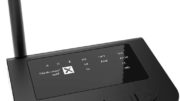So here’s the amazing thing. An antenna signal starts out as about 50,000 watts, sometimes less, going up a giant metal rod. Think about the power of 5,000 CFL light bulbs. That’s a lot of power. But say you’re about 50 miles away. where you should be able to get reception with a modest size antenna. The power of that signal has shrunk to a modest .00000001 watts, in other words, to where you would need about a hundred million signals just to power an LED.
The more you think about it…
Now first of all you could think about all that lost energy through attenuation, you could think about how wasteful that is, especially since you and 90% of your friends could be getting the signal through a cable anyway. Why put that 50,000 watt broadcast tower up there? But that’s not really the amazing part. The amazing part is that a signal that’s so weak that you couldn’t even detect it if it were a light bulb can bring you HD picture and 5.1 digital sound, right out of the air.
Yes, there is massive power loss through the air. You could eliminate that if you ran cables from every broadcast site to every home. But then again you’d need an incredible amount of wire to make that happen. In the end, it just makes more sense to use broadcasting even thought it’s so wasteful of power.
More sensitive antennas could make it possible to use less broadcast power, but that’s a long shot because you’d need to replace a lot of antennas.
Ground control to Major Tom
It gets even more amazing when you realize that you can pull signals the same way from satellites 22,000 miles away that aren’t broadcasting nearly as strongly. But then again, think of the Mars rover that broadcasts with its tiny antenna and is picked up on Earth, or the probes that have soared past Pluto, so far away that we don’t even get their broadcasts for over five hours. Those super-weak signals travel billions of miles and yeah, a lot of it is through open space but still. It’s so weak when it gets here that it takes an antenna the size of a baseball diamond to hear it, but it is still heard.
And then think for a second about how you have to point the remote control “just right” or your TV won’t change channels. Oh, sure there are RF solutions, and that’s not the point. But it’s just a juxtaposition between the amazing feats that are all around us every day and the frankly idiotic little things that come around to bother us.
It’s even more amazing when…
When you think about it, practically our entire modern life depends on some sort of broadcasting. It’s not just over-the-air television and radio. Those phones that are never too far from your hands are constantly broadcasting super-weak signals to nearby towers. Microwave arrays carry voice and data long distances when cables don’t make sense. Without a solid understanding of signal strength, we certainly would be much, much worse off. I’m sure you agree.





